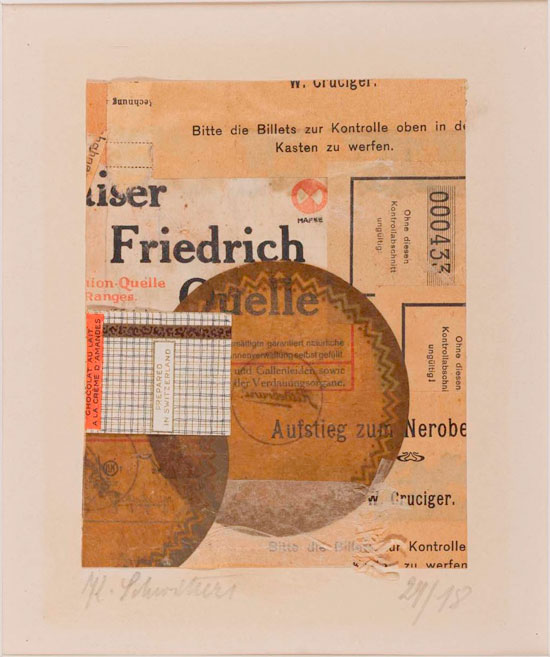Kurt Schwitters
Merzzeichnung 24/18 (Kaiser-Friedrich-Quelle), 1924
Paper collage
11,8 x 9,5 cm (picture)
© VG Bild-Kunst, Bonn 2022
Photo: Gerhard Sauer
Unlike artists such as Pablo Picasso or Hans Arp, who only occupied themselves for a short while with collages, Kurt Schwitters devoted himself to this technique his whole life long. It was the basis of his creative output, for he constantly employed the collage to transform garbage and objets trouvés into any number of widely varying artworks. By this means he expanded the concept of composition, which for him did not merely include colour, line, and form, but also the tactile aspect of the materials. With this idea of Merz art – the term was taken from the name of the Com[merz]bank which he found in an ad he used for an assemblage – from 1919 on he developed an art current in the provincial capital of Hanover that ran parallel to the Dada movement in Berlin and Zurich, which likewise questioned the way art had regarded up till then. Initially his Merz concept was applied solely to his artistic output, but soon he was to expand the idea – which essentially was based on the use of old materials and an openness in the arrangement – to include his wide range of activities as a sculptor, draughtsman, architect and typographer.
The collage Kaiser-Friedrich-Quelle from 1924 is one of his Merz drawings, as he termed these small compositions made of gummed down and sometimes overpainted paper. It has been pieced together from various scraps of paper he chanced upon – a chocolate wrapper, a transparent sweet package, an admission ticket, and the label from a bottle of seltzers named Kaiser Friedrich Quelle. The result is a composition that consists by and large of elements set on the vertical and horizontal. Two overlapping circular shapes tower up from the lower left-hand margin to the centre, where they loosen up the strict arrangement. The transparent materials open up the view to the underlying surfaces, giving a spatial effect that points to a Cubistic penetration of the surface to arrive at space. With its tactile quality, the creases in the packaging material also underscore the sensual aspect of the work and lend it an additional expressiveness. The overall geometricized nature of the picture points to the international style of Constructivism, which Schwitters explored from 1923 onward and whose success accompanied his own as an avant-garde artist. His position as a pioneer of new directions is also evident from his method of combining various genres in one. The close connection for instance between text and image, literature and the visual arts broke the boundaries in the early 20th century between the genres, quite in keeping with his personal vision of Merz art and paving the way for later art movements such as Pop Art and Fluxus. (Jutta Fischer)
Kurt Schwitters
1887 born in Hanover
1948 died in Kendal (UK)


